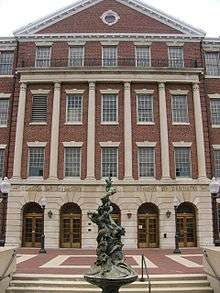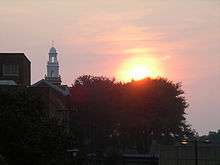Georgetown University School of Medicine
Georgetown University School of Medicine, a medical school opened in 1851, is one of Georgetown University's five graduate schools. It is located on Reservoir Road in the Georgetown neighborhood of Washington, DC, adjacent to the University's main campus. The School of Medicine works in association with the 609-bed Georgetown University Hospital, Washington Hospital Center, and nine other affiliated federal and community hospitals in the Washington metropolitan area. Georgetown is the oldest Catholic medical school in the United States.
 Seal of Georgetown University | |
| Type | Private |
|---|---|
| Established | 1851 |
Parent institution | Georgetown University |
| Affiliation | Roman Catholic (Jesuit) |
| Dean | Stephen Ray Mitchell, MD, MBA |
Academic staff | 1,638 |
| Students | 756 |
| Location | Washington, D.C. , USA |
| Campus | Urban |
| Website | som |
The School is part of the Georgetown University Medical Center, which comprises roughly 80% of the research initiatives occurring at Georgetown University as a whole. It is the closest academic medical center in proximity to the National Institutes of Health. Georgetown and the NIH offer a combined GU-NIH PhD program in biomedical research to foster direct collaboration between the neighboring institutions.[1]
Technology leading to the introduction of the HPV vaccine, was developed at Georgetown Medical Center by Richard Schlegel.[2]
History

In 1849, four Catholic doctors frustrated with what they felt were discriminatory practices at neighboring Columbian College, limiting Catholic doctors' access to the clinical facilities of the Washington Infirmary, petitioned Georgetown President James A. Ryder to found a medical program.[3] Classes commenced in May 1851 and were only held at night until 1895. In 1852, the school awarded its first medical doctorates.[4]
In 1898 the Georgetown University Hospital was established. A dental department was created in 1901, which became independent of the School of Medicine in 1951 as the School of Dentistry.[5] In 1930, classes moved to the main campus. In July 2000, Georgetown University and MedStar Health, a not-for-profit organization of seven Baltimore and Washington hospitals, entered into a clinical partnership to provide management of clinical care and clinical education at Georgetown University Hospital.[6] In 2004, the School of Medicine opened the Integrated Learning Center (ILC), which supports the School of Medicine's emphasis on a patient-centered, competence-based curriculum and provides the latest methods of clinical teaching and evaluation.
Curriculum
The Georgetown University School of Medicine Faculty includes 1,638 faculty members from 8 basic science and 16 clinical departments, a Cancer Center, and two Interdisciplinary Training Program Grants funded by the NIH – one in Neuroscience, and one in Tumor Biology.
The School of Medicine offers an MD with a Research Track where MD students spend time in the laboratory and develop a research thesis in their specialty. This is different from the MD/PhD program, which is longer and requires a PhD thesis.
The School of Medicine and the Graduate School of Arts & Sciences cooperate to offer a combined-degree program that leads to an MD and a PhD in a chosen concentration. A spot is reserved in this program each year for one student interested in pursuing a Philosophy & Bioethics PhD;[7] all other spots are undifferentiated but must be directed toward a scientific specialty. Research at Georgetown is especially strong in the areas of cancer and the neurosciences. Other combined degree programs include BA/MD (early selection route for Georgetown University undergraduates), MD/MBA, and MD/MS.
Programs
|
|
Campus

Georgetown University Medical Center comprises the School of Medicine, School of Nursing & Health Studies (founded in 1903), Lombardi Comprehensive Cancer Center and its Biomedical Graduate Research Organization. In 2008, GUMC brought in $132 million in sponsored research funds, most of which was federally funded. Clinical care is provided at Georgetown University Hospital and satellite locations through a partnership with MedStar Health.
Notable alumni
| Name | Degree and year received | Accomplishments |
|---|---|---|
| Mark R. Dybul | C 1985, M 1992 | United States Global AIDS Coordinator, U.S. Department of State, 2006–2008 |
| Susan Hockfield | Med Ph.D – 1979 | Neuroscientist; President, MIT, 2004–2012; Provost, Yale University, 2003–04; Dean, Yale Graduate School of Arts and Sciences, 1998–2000; |
| Kevin C. Kiley | M 1976 | Lt. Gen. Kiley is the 41st Surgeon General of the Army and Commander, U.S. Army Medical Command, 2004–2007 |
| Antonia Novello | Hospital Fellow 1975 | Surgeon General of the United States, 1990–93 |
| Esam Omeish | C 1989, M 1993 | former President of the Muslim American Society |
| Thomas Parran, Jr. | M 1915 | Surgeon General of the United States, 1936–48 |
| John J. Ring | C 1949, M 1953 | former President, American Medical Association |
| Lana Skirboll | Ph.D – 1977 | former Director, National Institutes of Health Office of Science Policy |
| Solomon Snyder | C 1959, M 1962 | Neuroscientist |
| Andrew von Eschenbach | M 1967 | Director, Food and Drug Administration, 2006–2009; Director, National Cancer Institute, 2002–05; Director, BioTime, a biotechnology company, 2011–present |
References
- "GU-NIH Graduate Partnership Programs in Biomedical Sciences". Peterson's. Retrieved 19 March 2017.
- SooHoo, Cheryl (Winter 2011–12). "Alum Dick Schlegel Gives Cancer Prevention His Best Shot". Ward Rounds. Northwestern University. Retrieved 19 March 2017.
- O'Neill, Paul R.; Williams, Paul K. (2003). Georgetown University. Charleston, South Carolina: Arcadia Publishing. ISBN 0738515094.
- Shea, John Gilmary (1891). "Chapter XXIII: Father Charles H. Stonestreet, S.J.". Memorial of the First Century of Georgetown College, D.C.: Comprising a History of Georgetown University. 3. New York: P. F. Collier. p. 176. OCLC 612832863. Archived from the original on January 12, 2019. Retrieved January 12, 2019 – via Google Books.
- "Dental Alumni History: 1930–1960". alumni.georgetown.edu. Archived from the original on September 10, 2015. Retrieved September 12, 2015.
- Goldstein, Avram (18 February 2000). "MedStar, GU Strike Hospital Deal". Washington Post. Retrieved 19 March 2017.
- "M.D./Ph.D. Program". Georgetown University School of Medicine. Retrieved 19 March 2017.